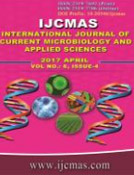


 National Academy of Agricultural Sciences (NAAS)
National Academy of Agricultural Sciences (NAAS)

|
PRINT ISSN : 2319-7692
Online ISSN : 2319-7706 Issues : 12 per year Publisher : Excellent Publishers Email : editorijcmas@gmail.com / submit@ijcmas.com Editor-in-chief: Dr.M.Prakash Index Copernicus ICV 2018: 95.39 NAAS RATING 2020: 5.38 |
A field experiment was conducted to score the comparative efficiency of biocontrol agents in the management of root borne diseases of Coleus forskohlii (cv.K-8). The crop has a great potential demand for forskolin (Diterpene) with wide application in treating many human diseases. However, the crop has become unpopular among farmers due to the susceptibility to many diseases of which root rot and wilt is the most serious causing loss in tuber yield and makes the crop uneconomical. The bioinoculants such as Azotobacter chroococcum (N fixer), Bacillus subtilis, Pseudomonas fluorescens, Trichoderma harzianum and Glomus fasciculatum (AM Fungi) were used as potential biocontrol agents in the study. To quantify the disease severity per cent disease index (PDI) was calculated. The least disease incidence with improved plant health and maximum tuber yield was found to be in the treatment of 100% NPK with combined inoculation of all the consortia followed by plants inoculated with same consortia plus 75 % NP with 100% K. The highest disease incidence and least tuber yield were recorded in control plants with 50 % NP plus 100% K without any consortia. This indicates that economically advantageous yields with lowest disease incidence can be obtained with 75 % NP with 100% K and a saving of 25 % N can be achieved by using above consortia. This could be attributed that due to the effective use of microbial biogents with graded level of inorganic fertilizers. Hence, the present study aims at novel approaches to control diseases of Coleus and its economical management.
 |
 |
 |
 |
 |